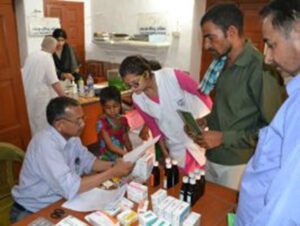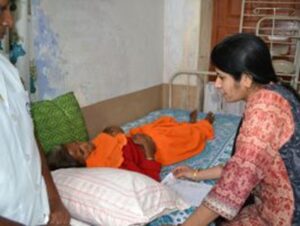Annual Report 2016-17:
GPH Annual Report 2016-17: Cancer Clinics
Ganga Prem Hospice hosted thirteen charitable cancer clinics during the 2016-17 year – twelve in Rishikesh and one in Haridwar.
A total of 1177 patients received care at these clinics, with an average for the year of 92 patients per clinic. The largest clinic (118 patients) was in August, and the smallest (57 patients) was during the wedding/holiday season of October. About half of the total patients were from Rishikesh, 231 from Dehradun, 208 from Haridwar, 89 from cities in the plains region, and 61 from towns or villages in the Himalayan hills. The male-female ratio of patients was exactly 60:40. GPH patients are overwhelmingly Hindu (94% at the 2016-17 clinics,) which is a simple reflection of the greater demographics of the Uttarakhand Himalayan region.


While the primary aim of the free GPH clinics is the diagnosis and follow-up care of cancer, anyone with health concerns is granted a doctor’s visit at the clinic. This year 52% of the total patients seen at the clinics were suffering from cancer, and amongst these 11% were terminally ill cancer patients. An additional 8% presented symptoms associated with cancer and these were sent for appropriate diagnostic testing as a first step in their continued care. Head and neck cancers were by far the most prevalent cancers observed at the clinics, accounting for almost 40% of the total with 244 cases. The second most common category was breast cancer with 91 cases, followed by abdominal cancers (71,) reproductive organs (44,) lungs (40,) bones (11,) and blood (7.) Other miscellaneous cancers afflicted the remaining 105 patients.


The GPH clinic staff is augmented by a team of local and visiting doctors and volunteers, with at least one oncologist at every clinic. There were between three to nine doctors in attendance at each clinic, with an average of six to seven doctors per clinic, including oncologists, palliative care specialists, gynecologists, dentists, general practitioners and an onco-psychiatrist. The clinics have enjoyed as many as 21 volunteers (including volunteer doctors,) and as few as four at the April 2016 clinic in Haridwar, but on average the clinics were supported by around eleven or twelve volunteers. Many of these were international visitors who joined the local regulars in their monthly service, and all find meaning in helping others in need through the Ganga Prem Hospice charitable clinics.
Annual Report 2016-17: Volunteers
From its inception, Ganga Prem Hospice has relied heavily on the generosity of its volunteers from all over the world and all walks of life.
Over the course of the year, April 2016 – March 2017, a total of 4470 hours of local volunteer time were logged in the course of GPH’s charitable work. Eighty-one Indians and thirty-one visiting foreign nationals offered a wide range of skills – from minor medical procedures to web design, from art therapy to plumbing – though the majority of the volunteer hours were accrued by medical professionals in the home care program and at the monthly free cancer clinics in Rishikesh.
Special events throughout the year, such as the Krishna Das concert fundraiser and the GPH Christmas party, also relied on numerous dedicated volunteers for their success.
The month of February led the year with 740 volunteer hours. Visiting British palliative care specialist Dr. Brenda Ward, who has been supporting GPH for the past four years with medical leadership, this year offered 397 hours of her time to the terminally ill patients of Uttarakhand. Local Rishikesh volunteer Raj Mehra contributed the most hours of any volunteer, logging 584 hours of work this year with the administrative team.

GPH would like to thank each and every person who helped in any capacity this year to bring much needed care, support and joy to the terminally ill cancer patients of Uttarakhand.
Annual Report 2016-17: Home Care
For the GPH operational year from April 2016- March 2017, a total of 284 patients received home care visits from the GPH team: 132 in Dehradun, 86 in Rishikesh and 66 in Haridwar.
These figures reflect the relative size of the three cities, as well as travel distance for hospice staff, with three vehicles based in Rishikesh and one based in Dehradun for much of the year. A total of 13 doctors, 27 nurses, 28 volunteers, 2 masseuses and 4 drivers joined the team at different times and for varying durations throughout the year to provide home care.


The total number of visits for the year was 2781. On average, there were a total of 231 visits per month, with September registering the most visits (299) and November the fewest visits (129.) As might be expected, variance in number of visits per month roughly corresponds with number of patients requesting home care: November had the fewest patients (42) and September the second most patients (69.) Additional variation in number of visits per month can be explained by fluctuations in available staff and volunteers. When visiting medical professionals joined the team for a period of weeks or months, home visits naturally increased in number.
Most (69 out of 284) of the home care patients were between the ages of 61 and 70; fewest (6) were between the ages of 21 and 30. Breast cancer was the most common type of cancer (37 out of 284,) followed by lung (28,) ovary (20,) oesophagus (17,) tongue (16,) gall bladder (16,) and buccal mucosa (13.) 51 other specific types of cancer were recorded in the single digits. However, taken as a group, head and neck cancers numbering 71 cases (25%) were by far the most prevalent relative to any other category of cancer. This unfortunate statistic is also reflected in the GPH cancer clinic figures, and clearly linked to the prevalent use of tobacco products and paan products.


GPH also records the financial status of its patients and helps the poorest families receive additional aid in the form of free rations, hospital grants, school fees and so forth. Based on their income, most of the home care patients were categorized as Lower-Middle Class (104,) followed by Poor (73) and then Very Poor (46.) The remaining 61 patients were Upper-Middle Class or Well-Off. Religious views of GPH patients reflect the overwhelming Hindu majority of the Himalayan foothill region: 248 were Hindu, with remaining few following the Sikh, Muslim, Jain, and Christian faiths.
